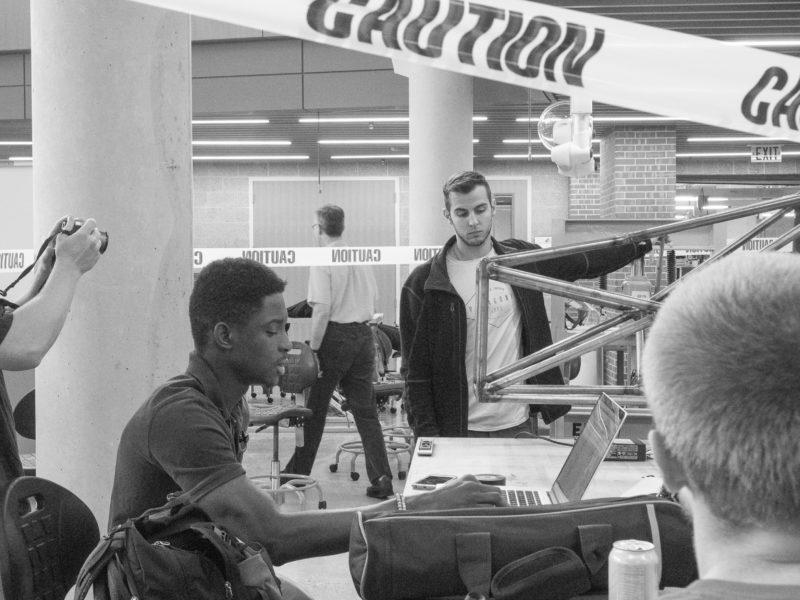A team comprising of senior engineering science students Michael Robison, Todd Edwards, Hamza Adisa, Nate Kiszla and Austin Haas has been constructing Trinity University’s first Formula One race car for their senior capstone project.
The project, which involves the deconstruction of a snowmobile for its engine and other useful components, is part of a goal to eventually compete at a Formula SAE student design competition, organized by SAE International. The competition involves the meticulous construction, testing and racing of cars by students from around the world.
“We’ve always had groups of students who have wanted to race, but were discouraged by the cost and technicalities,” said Jack Leifer, professor of engineering science at Trinity and faculty advisor for the group in the fall. “If I have met a group of students who could do it, it’s these students.”
The car has been in the works for the past year, beginning with a presentation in the spring of 2016.
“Last spring, we got together and talked about the project, what we wanted to do and our goals, developed a project charter and a project plan and proposed it,” said Michael Robison, lead student on the project. “In the fall is when we started designing. We started making a lot of design decisions from the systems engineering standpoint “¦ to get a picture of what we would be able to do and how we were going to build it.”
Getting to the design process was no easy undertaking, as the group had to fundraise around $55,000 in order to purchase a snowmobile and the necessary tools in order to construct the vehicle.
Typically, schools with established FSAE programs have multiple cars already built, $100,000 to $1,000,000 budgets and teams of 50 to 100 people. These vehicles also can be re-entered as long as the car’s frame is reconstructed, as per competition rules.
“In bigger schools, for their senior project one year, teams will choose to rebuild, re-optimize or redesign a certain component in the car,” Robison said. “The difficulty with starting a project here, with only five of us, is we don’t have a car, we don’t have any infrastructure, we don’t have any of the experience. We had to start from scratch, basically.”
Unfortunately the specificity of the competition and the difficulty of completing certain technical forms led to the team being unable to submit their car for competition this June.
However, their goal is to construct as much of the car as possible this year to leave behind for future FSAE projects. The team will continue working toward their capstone presentation on April 27, which involves a series of structural tests on the frame of the vehicle.
“We’ve already put together another group of [underclassmen] students who are ready to modify this vehicle,” Leifer said. “This group [of seniors] has developed a legacy and the intention is to continue and modify this car, build additional cars and compete in the future.”
Morgan Jones, a sophomore engineering student who has been working closely with the senior design team, jumped at the chance to be a part of the construction of the car.
“Knowing that there were people who were actually motivated to do this huge project that most larger schools do, and smaller schools often don’t, I definitely wanted to be a part of it,” Jones said. “It was very clear to me that the engineering design experience that you get from doing this project is unparalleled.”
Jones, who is planning on being a part of future FSAE teams, is looking forward to the attention this project will bring to the engineering science program at Trinity.
“Kids who come to this school should really see something like this,” Jones said. “They should see that there are students in a small school capable of building these large vehicles. If we can make our team grow, that will definitely attract tons of other students, both locally and from around the world.”
The engineering department is also excited for the future of FSAE projects at Trinity.
“What I really liked about this competition is that the purpose is really well aligned with the course objectives that we have for senior design,” said Farzan Aminian, chair of the engineering science department. “Obviously this was an ambitious project to finish in about eight months, but we tried to be realistic in what can be done in eight months. We’re really looking at this to be a multi-year project so that we can get to a point where we can be visible in this competition on an annual basis.”
The finished product will be a testament for the level of excellence Trinity students can achieve, all beginning with this year’s senior design team.
“Assuming we display this vehicle somewhere in the [Center for Science and Innovation] building, it will be an attention-getter,” Leifer said. “It will show what you can accomplish with a Trinity engineering education.”







